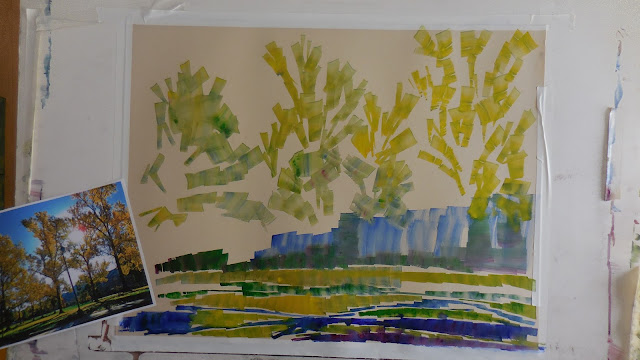Here you can see the reference photo I took in Irvine Park in the early fall.
In this painting I have tried to keep the colors and shapes separate so I can have a clear idea of the accuracy of the shapes.
This painting was built up layer after layer. There were multiple sessions where I put down water color. The values were not as important here beyond establishing a comparison from dark to light.
This painting took longer to get the values where I wanted them because I was afraid to make a mistake. This subject was important to me and it was important to not waste my time by failing.
A neat pallet in my mixed media paintings is not a priority for me. The under painting is the base which I build upon. It is something to interact with and to react to. Using complimentary colors to create grays in the under painting helps support the vibrancy in the final stages of the painting.
While building this painting, I am constantly thinking about what I am doing with water color and how I will bring out the final colors and values.
The darker and grayer I can get in the under painting, the more striking the final painting will be.
The abstract nature of the parts of the painting are brought into context when they are assembled fully.
I like the complexity of shapes and color. They create an implied detail without the restraint of slavishly trying to recreate the exact scene.
The water color under painting allows me to explore shapes and color without the risk I will take in the later stages of the painting. Any mistake can be painted over with little or no effort.
As I became more confident in the shapes, value, and color in the under painting, I did not rely on the separation of shapes as much.
There is no intent to create abstract shapes within the painting. They exist in the painting because of the freedom and confidence in my expression. Control at the cost of expression is not worth the effort.
These paintings are as much about my feelings for them as they are about the place I am painting.
At the end of this part of the painting I felt the need to make sure the entire surface was covered to some degree of paint.
The adjustment of values continues till the end of the painting. The beauty of pastel is that because it is a dry application, values can be worked in all directions not just from dark to light.
Here I have continued to create greater definition of shape, depth of value, and deeper vibrancy of the color.
When the start of the painting has been really established according to the initial goals and thoughts, the later stages seem to be a logical progression till the end.
It is important to keep the final highlights off the painting till the very end. Otherwise the painting looses its freshness and looks overworked.
One of the biggest challenges in this painting was to describe the brightness of the sun behind the leaves of the poplar trees.
I really enjoy the complexity of color and diversity of mark making that you can achieve through this technique.
The smooth washes of water color contrasted with the drawing and mark making of pastel create a dynamic and balance within the painting.

One of the trends in my recent painting efforts revolves around the idea of addition vs. subtraction. When working with water color and pastel, there is this give and take between the two. You first give with the water color. By adding pastel over the water color you are adding to the painting but you at the same time are subtracting or covering up something you have already put down. Addition by subtraction.
At the same time you are adding and subtracting you are creating this dynamic interaction between the mediums. While this is all going on is my impressionistic approach to color.
The shapes are in place, the colors and values are locked in for the most part. The focus is the finish.
The lightest values and colors still need to be added. The other focus is the edges of the shapes.
Through my devotion to plein air painting, I am better able to take advantage of painting from reference photos. One of the advantages of working from photos is that the camera can catch some lighting effects that are hard to visualize while painting. For example the red in the foliage of the Poplar trees. I would have to squint like crazy to study that part of the composition. I would probably come up with something quite different on site.
 |
The last question to be answered. When is enough-enough?
|
The value shot.
The detail shot.































No comments:
Post a Comment